4
ConnectED: Bridging Minds Building Communities
ConnectED: Bridging Minds Building Communities
Apie
Growing up today can be tough. Young people face stress, confusion, and big changes—and often feel unprepared. That’s where ConnectEd comes in.
This playlist helps youth workers and educators support young people with the skills they really need—like managing stress, solving problems, and working well with others. Through fun, hands-on activities and simple tools, young people learn how to build confidence, stay strong during hard times, and connect with others.
With a focus on learning how to learn, building community, and caring for mental health, ConnectEd helps young people feel ready for whatever comes next. Whether in a classroom, online, or in a youth group, these activities are easy to use and full of real-life value.
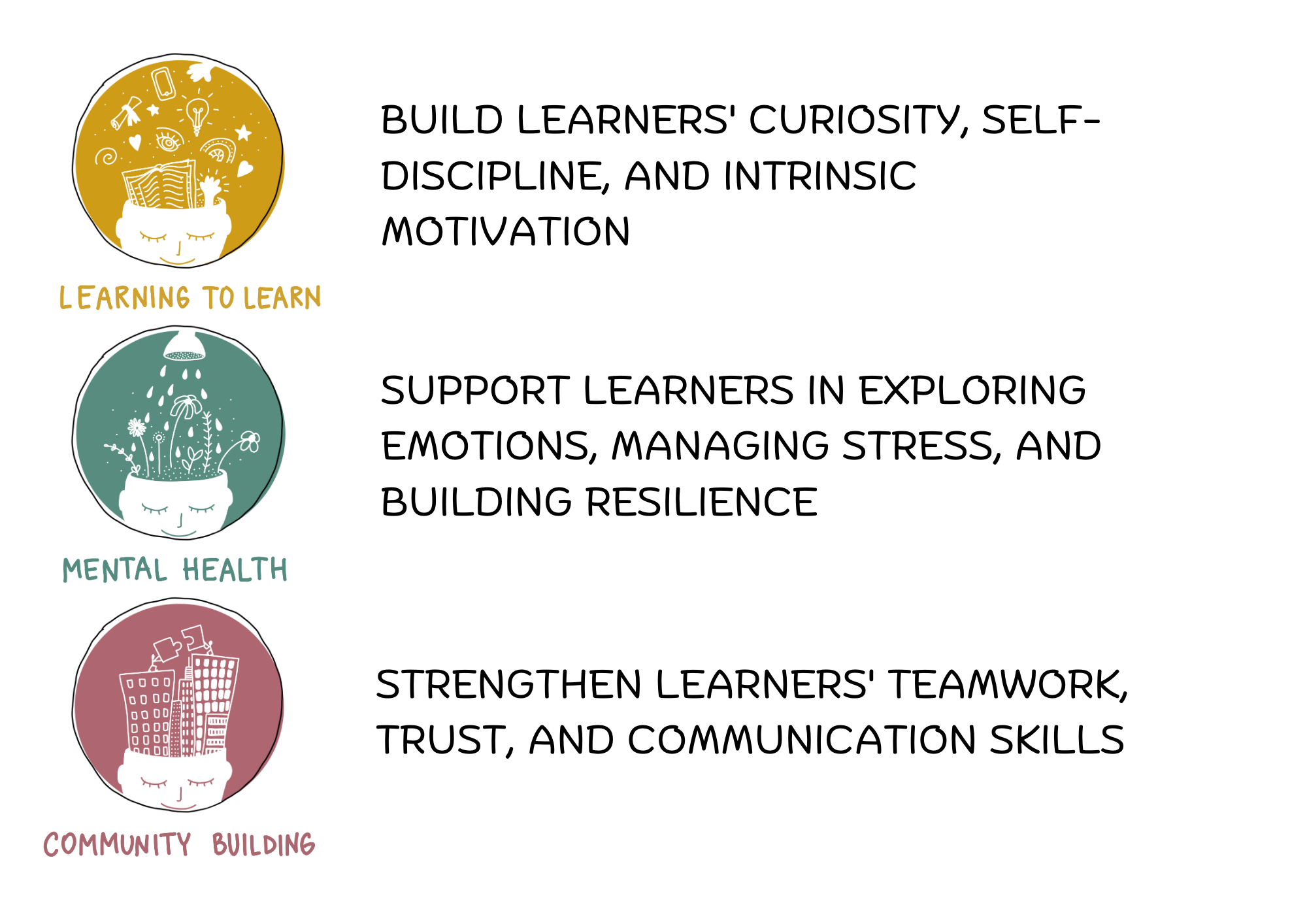
If you’ve ever seen a young person struggling and wished you could do more—ConnectEd gives you the tools to help. Offer them the support they deserve. A safe space. A helping hand. A moment that could change everything.
About the ConnectEd Project
The ConnectEd methodology was developed as part of the ConnectED: Bridging Minds, Building Communities project, a collaborative initiative aimed at strengthening the capacity of youth workers and educators. The ConnectEd project is implemented by TiPovej! from Slovenia, BACKSLASH from Spain, Libero from Serbia, and Connect International from Belgium.

Baigti renginius
Atlikite šias veiklas, gaukite ženkliukus ir pamatysite grojaraščio progresą
Apie
Understanding Mental Health: What Does It Really Mean?
Let’s talk about mental health in a way that makes sense and helps you better understand how to support young people.
What is Mental Health?
Mental health is about how we feel, think, and act. It’s our overall emotional and psychological well-being. When we have good mental health, we can:
- Handle stress in our daily life
- Feel good about ourselves
- Work productively and do well in school or jobs
- Contribute to our communities
In simple terms, mental health is about feeling balanced and being able to manage life’s challenges.
Mental Health vs. Mental Illness
Mental health is about our emotions and thoughts on a regular day. It’s like when you feel happy, sad, stressed, or even excited. But mental illness is different. It happens when a person’s thoughts, feelings, or behaviors get really out of balance. For example, if someone has depression or anxiety, it can affect their ability to think clearly, control their feelings, or behave in ways they want to. These conditions can make it hard to do normal activities like going to school, working, or talking to friends.
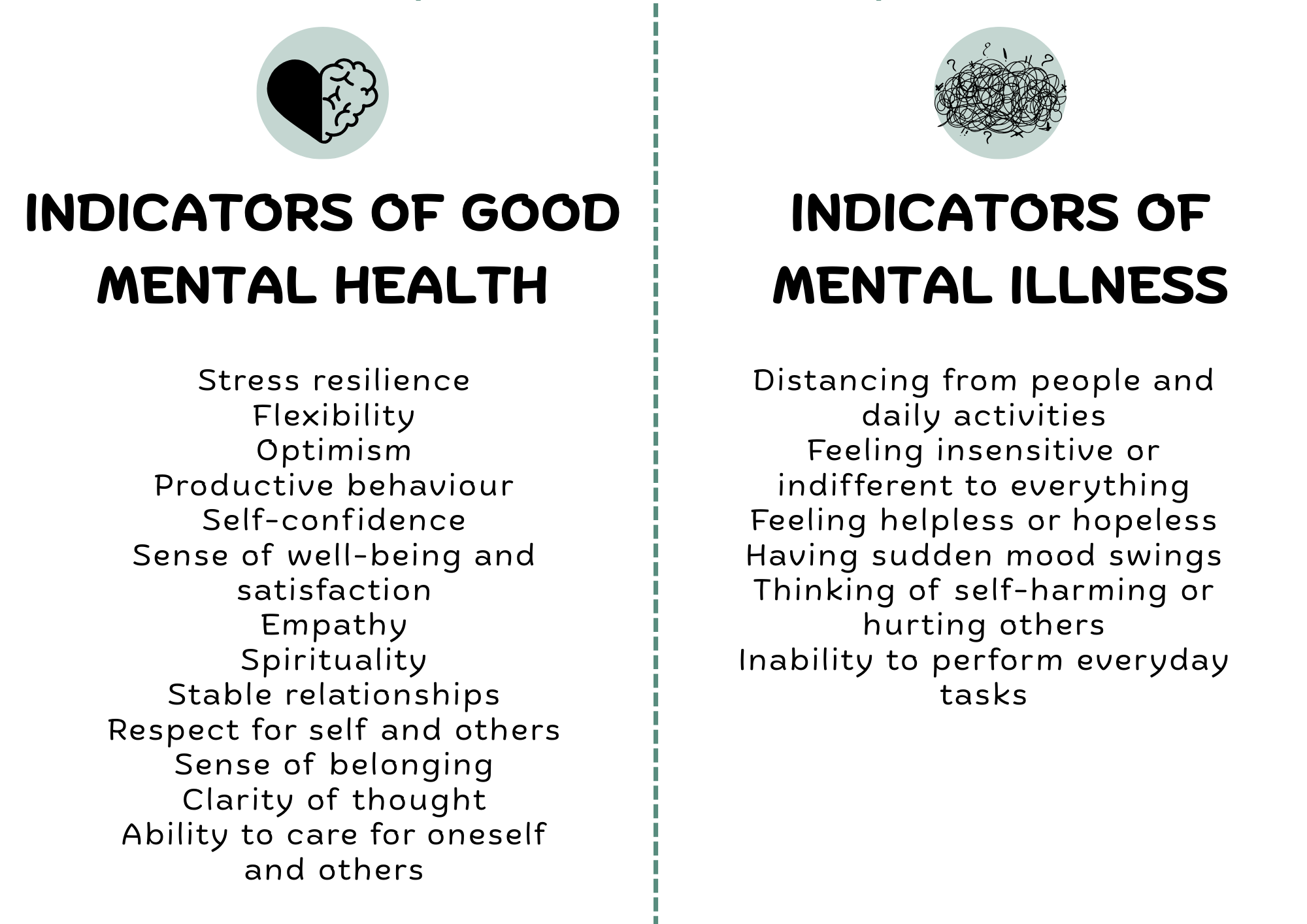
Let’s deeper into the topic:
Now, Here’s a Quick Activity for You!
Can you spot the difference between mental health and mental illness?
1. Feeling anxious before a big test.
- Mental Health or Mental Illness?
2. Struggling to get out of bed for weeks because you feel sad all the time.
- Mental Health or Mental Illness?
Think about these scenarios. How can you support someone in each situation? The more you know, the better you can help young people with their mental well-being! Share your answers below to complete the task 2 to earn badge for this activity.
Mental Health: Myth or Fact? Let’s Find Out!
Many people believe things about mental health that just aren’t true. These myths can cause fear, confusion, and stop people from getting the help they need. It’s time to learn the facts and stop the stigma!
Let’s learn the truth about common mental health myths — and test your knowledge with a fun quiz! Understanding the facts helps us support others, speak up against stigma, and take care of our own mental well-being too.
Take this short quiz to find out if you can spot the myths from the facts! 👉 Click HERE to take the quiz. When you finish, take a screenshot of your results. At the end of this learning activity, attach the screenshot and submit it as part of your evidence for task 1.
Emotions, Feelings, & Moods: Know the Difference!
Knowing the difference between emotions, feelings, and moods is really important for our mental and emotional health. It helps us understand why we feel the way we do and how to manage those feelings better.
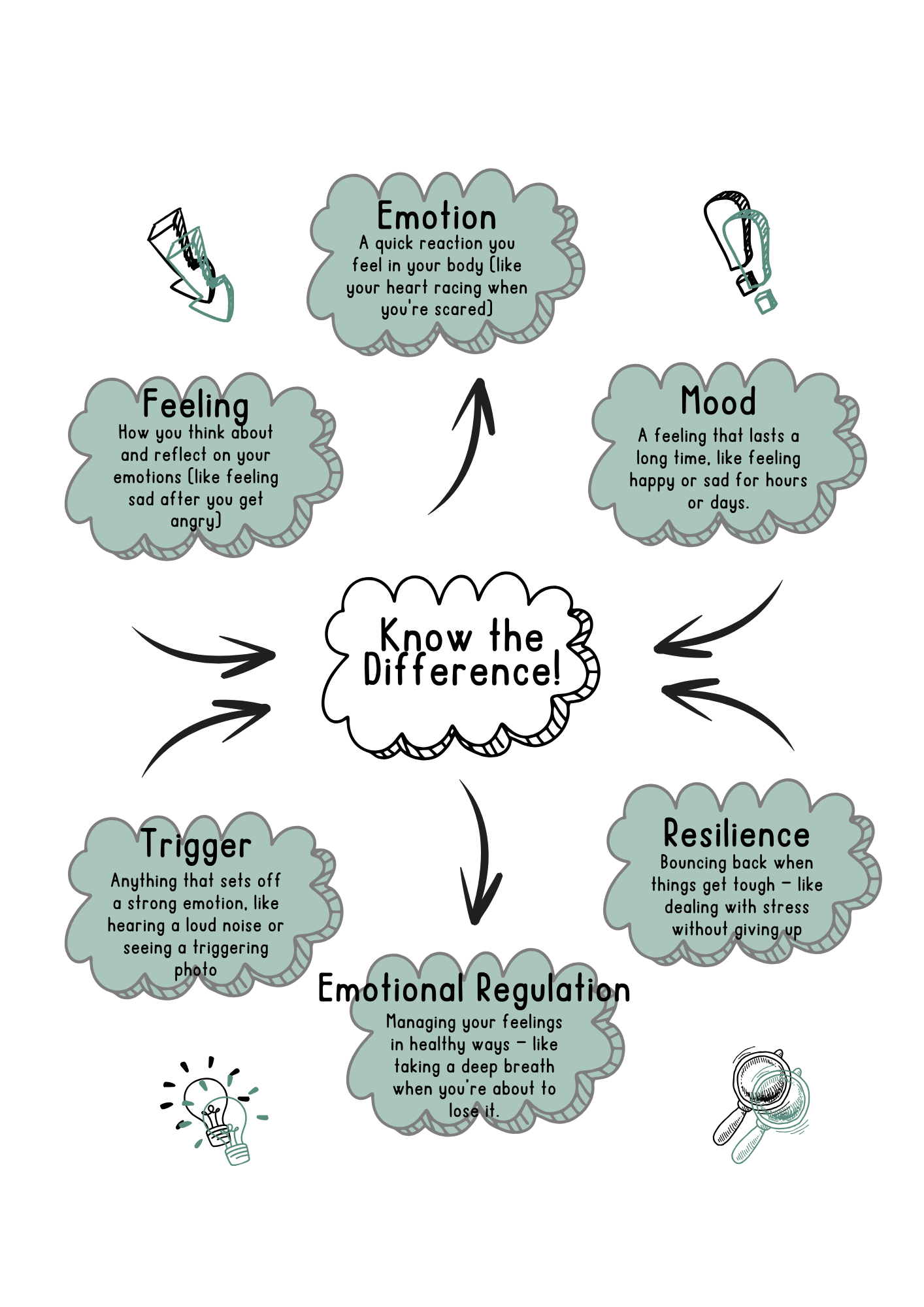
Triggers: What Are They and Why Do They Matter?
Understanding triggers is a big part of supporting young people with their mental health. Let’s break it down in a simple and clear way. A trigger is something that causes a strong emotional or physical reaction—like fear, anger, or sadness. Triggers are often connected to past difficult or traumatic experiences.
When someone is triggered, they may suddenly feel like they’re back in a painful or stressful moment, even if it happened a long time ago.
Types of Triggers
There are two main kinds of triggers:
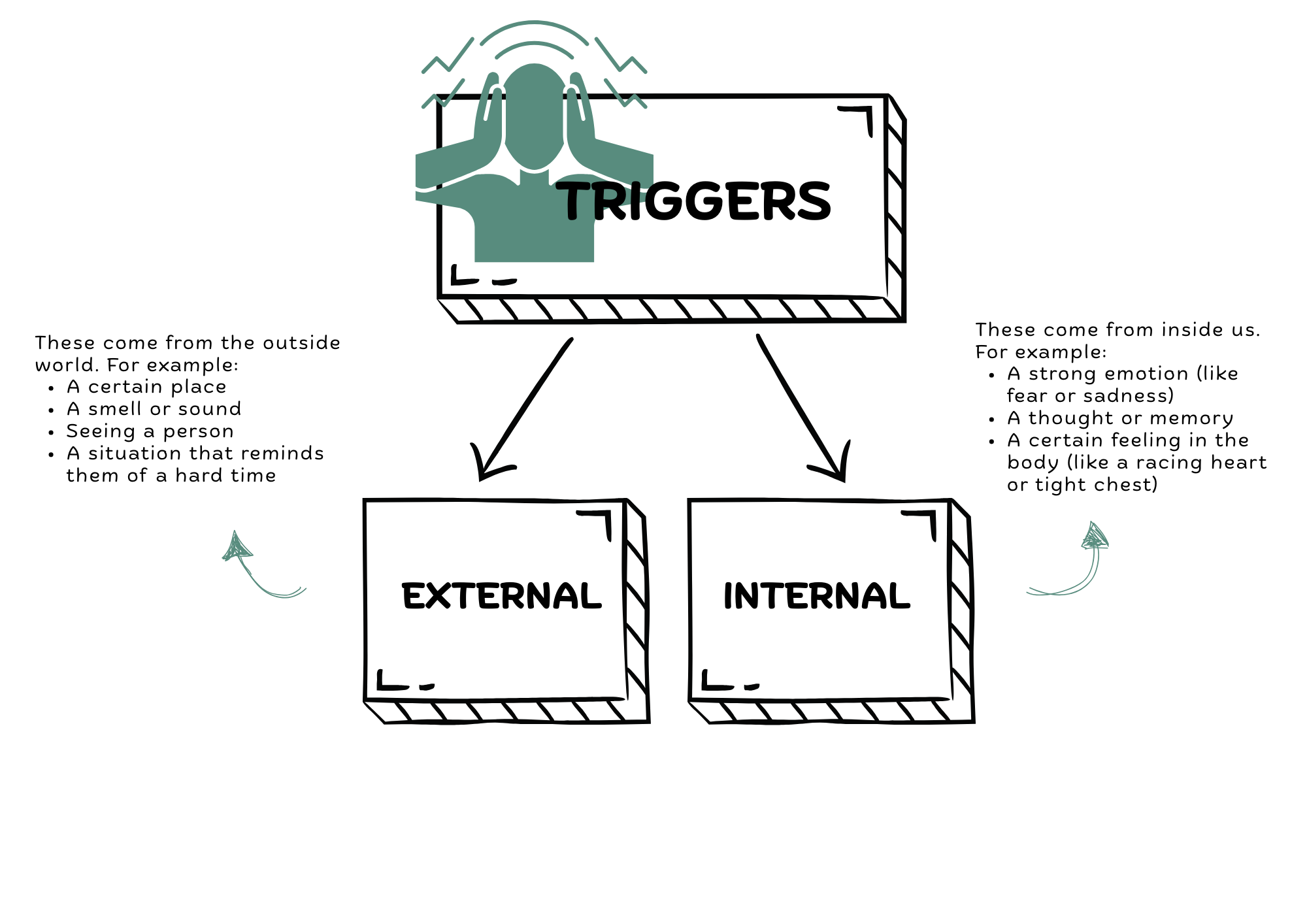
How Triggers Affect Us
When someone is triggered, they might experience things like:
- Flashbacks or memories – It feels like the bad thing is happening all over again.
- Body reactions – Their heart might beat faster, they might start sweating or feel like they can’t breathe well.
- Avoidance – They might try to stay away from people, places, or things that remind them of that experience, even if it makes daily life harder.
- Mood changes – They may feel anxious, angry, sad, or hopeless.
This video by The School of Life explains why we get emotionally triggered and how to stop it:
Think about these questions:
- Have you ever seen a young person suddenly react strongly to something small? Could it have been a trigger?
- What’s something you could do to help someone feel safer when they’re triggered?
- How can you support a young person without pushing them to talk about things they’re not ready for?
Take a few minutes to write down your thoughts or talk about them with a teammate.
Resilience & Emotional Strength
Resilience means being able to bounce back from stress, hard times, or change.It helps us deal with pressure, stay calm in hard moments, keep going, even when things feel tough.
Let’s break it down into simple tools that young people can use. You can show this like a “Resilience Toolbox:”
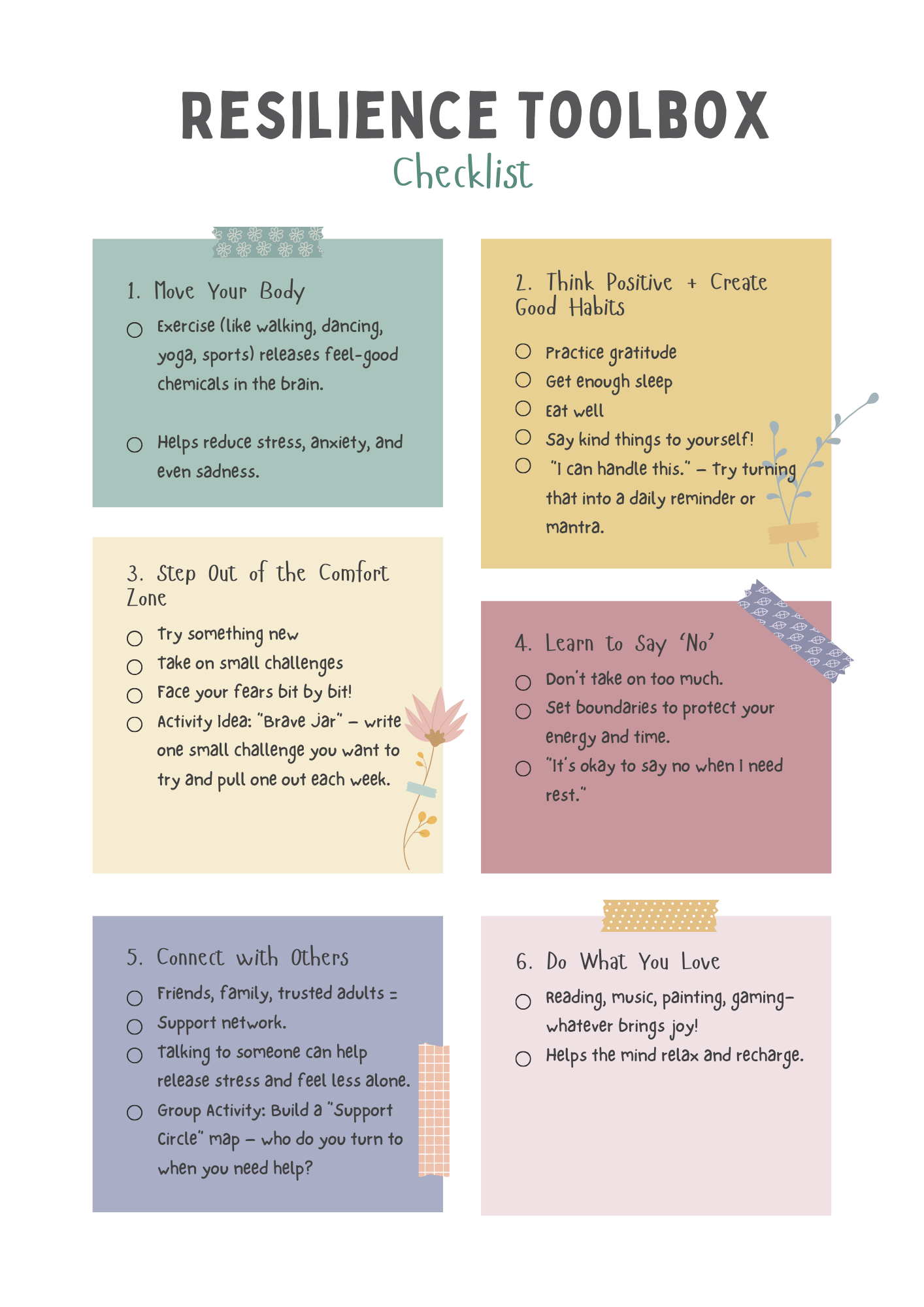
Emotional Regulation is about understanding and managing your emotions, instead of letting them take over.Here is two hacks you can share with young people:
A Quick Reflection Exercise you can do with your group. Ask them:
- What helps you bounce back after a hard day?
- What’s one small habit you want to build to feel stronger inside?
- Can you think of a time you managed your emotions well? What helped?
Tolerance, Respect & Empathy
Tolerance means accepting and respecting people who are different from you. It’s about welcoming diversity—different cultures, beliefs, looks, abilities, and ways of living.
Respect is about seeing value in every person—no matter where they come from or how they live. It means:
- Listening without judging
- Being kind even when we disagree
- Standing up when others are being treated unfairly
Empathy means feeling with someone, not just for them. When you practice empathy: (1) you understand how others feel; (2) you care about their struggles; (3) you act with kindness, not judgment.
Try This: "Walk in Their Shoes"
- Think of a time someone misunderstood you.
- How did that feel?
Now flip it: Think of someone you might have misunderstood.
- What could you do differently next time?
Helping young people grow in tolerance, respect, and empathy isn't just good for society - it directly supports their emotional well-being, self-esteem, and resilience.
What is one small way you’ll promote tolerance, empathy and respect this week—with your group or your peers?Share your answer below to complete task 4.
You may use the exercises listed in the methodology “ConnectEd: Bridging Minds, Building Communities” to support young people in better understanding of mental health.

Gauk veiklos ženkliuką
MENTAL HEALTH Gauk šį ženkliuką
This badge is for youth workers and educators who’ve taken meaningful steps to explore mental health in a real, relatable way—so they can better support young people in their everyday lives.
By earning this badge, you’ve shown a commitment to understanding what mental health really means—not just as a topic, but as a vital part of every young person’s life. You’ve learned to spot the difference between mental health and mental illness, explored the impact of triggers, and reflected on your role in building empathy, resilience, and respect.
This isn’t just about knowledge—it’s about action. You’ve dug deep, reflected honestly, and are now more prepared to create safe, supportive spaces for youth to grow, heal, and thrive.
What you did to earn this badge:
- Took a quiz to bust common myths about mental health and fight stigma
- Practiced telling the difference between everyday mental health struggles and signs of mental illness
- Reflected on emotional triggers and how to respond with care and understanding
- Thought about how to build tolerance, respect, and empathy in your youth groups
- Gave thoughtful feedback to help shape better learning experiences for others
By completing this activity, you’ve proven that you:
- Understand what mental health means in everyday life
- Are aware of how trauma and triggers can impact young people
- Know how to support youth in simple, practical, and respectful ways
- Are ready to promote safe spaces where young people feel seen, heard, and valued
- Are growing not only as a youth worker—but as a champion for well-being
This badge shows you’re ready to stand alongside young people on their mental health journeys—with empathy, awareness, and purpose.
Užduotys
Užduotis nr.1
Išduoda organizatorius arba nuskaitant QR kodą
Task 1: Let's Talk About Mental Health: Myth or Fact?
Let’s Find Out!When you finish the quiz, attach the screenshot of your results.
Užduotis nr.2
Išduoda organizatorius arba nuskaitant QR kodą
Task 2: Spot the difference
Now, Here’s a Quick Activity for You!
Can you spot the difference between mental health and mental illness?
1. Feeling anxious before a big test.
- Mental Health or Mental Illness?
2. Struggling to get out of bed for weeks because you feel sad all the time.
- Mental Health or Mental Illness?
Share your answers below.
Užduotis nr.3
Išduoda organizatorius arba nuskaitant QR kodą
Task 3: Triggers
Think about these questions:
- Have you ever seen a young person suddenly react strongly to something small? Could it have been a trigger
- What’s something you could do to help someone feel safer when they’re triggered?
- How can you support a young person without pushing them to talk about things they’re not ready for?
Take a few minutes to write down your thoughts.
Užduotis nr.4
Išduoda organizatorius arba nuskaitant QR kodą
Task 4: Tolerance, empathy and respect
What is one small way you’ll promote tolerance, empathy and respect this week—with your group or your peers?
Share your answer below.
Užduotis nr.5
Išduoda organizatorius arba nuskaitant QR kodą
Task 5: Give us your feedback
- What was the most important takeaway for you from this activity, and how do you think it will help you support young people better?
- Were there any parts of the activity that felt unclear, too complex, or less engaging for young people? How could we improve it?
- What part of the activity do you think will be most helpful or meaningful for the young people you work with—and why?
Share your thoughts with us.
Įgūdžiai
ESCO
#able to use learning strategies
Renginiai: 3
Pradėta: 6
Pabaigė grojaraštį: 0
Laikas pabaigti: 6 valandos
Dalintis:
Organizatoriai
TiPovej!
Badge issuer recognized with
Awero palaiko šią platformą ir plėtoja ją kartu su pagrindinėmis švietimo organizacijomis. Europos Sąjungos programa Erasmus+ dalinai finansavo pirmosios platformos versijos sukūrimą. Susisiekite su mumis support@Awero.org.
Platforma
Pakeisti į kitą kalbą:

